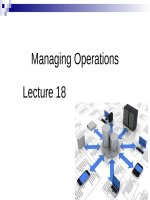Lecture Business management information system - Lecture 14: Managing telecommunications
Bạn đang xem bản rút gọn của tài liệu. Xem và tải ngay bản đầy đủ của tài liệu tại đây (1.28 MB, 54 trang )
Managing
Telecommunications
Lecture 14
Telecommunications
n
Telecommunications is the flow of information among
individuals, work groups, departments, customer sites,
regional offices, between enterprises, and with the
outside world
n
The Internet has also opened up a “cyberspace” where
people can be in a virtual world, where organizations can
conduct business, and in fact, a place where
organizational processes exist. This is providing the
foundation for the e-business economy, as just about
everything about telecom is shifting
Today’s Lecture
n
Introduction
n
The Evolving Telecommunications Scene
¨ A New Telecommunications Infrastructure is Being
Built
The Telecom Industry is Being Transformed
¨ The Internet is the Network Of Choice
¨ Digital Convergence Has Become a Reality
¨ The OSI Reference Model Underlies Today’s
Networks
¨ The Rate of Change is Accelerating
n
Today’s Lecture
¨ The
Optical Era Will Provide Bandwidth Abundance
¨ The
Wireless Century Begins
¨ Messaging
is a Killer App
¨ Coming: An
n
Internet of Things
The Role of the IS Department
Introduction
n
Telecommunications = electronically sending data in any
form from one place to another between
¨ People
¨ Machines, or
¨ Objects
Introduction...
n
Generally, IS departments have been responsible for
designing, building, and maintaining the information
highway in the same way that governments are
responsible for building and maintaining streets, roads,
and freeways
n
Once built, the network, with its nodes and links,
provides infrastructure for the flow of information and
messages
Introduction…
n
n
n
In early 2000s Telecom became the basis for the way
people and companies started working
¨ It provides the infrastructure for moving information
and messages
South Korea’s largest telecommunications firm.
It is able to transmit data at a rate of 4 megabits per
second, about four times faster than the typical cable
modem deliver-ing high-speed Internet service to U.S.
households.
Introduction...
n
The company uses radio sensors to track the movement
of parts as they move from fabrication shop to the side of
a drydock and then onto a ship under construction.
n
Workers on the ship use notebook computers or
handheld mobile phones to access plans and engage in
two-way video conversations with ship designers in the
office, more than a mile away.
In Past
n
n
n
In the past, workers who were inside a vessel below
ground or below sea level had to climb topside to use a
phone or walkie-talkie when they had to talk to someone
about a problem.
The new wireless network is connected to the electric
lines in the ship, which convey digital data
HYUNDAI HEAVY INDUSTRIES CREATES A
WIRELESS SHIPYARD to Wi-Fi wireless transmitters:
placed around the hull during construction. Workers’
Internet phones, webcams, and PCs are linked to the WiFi system, so workers can use Skype VoIP to call their
colleagues on the surface.
Contin…
n
n
n
n
Designers in an office building a mile from the construction site use the webcams to investigate problems.
On the shipyard roads, 30 transporter trucks fitted to
receivers connected to the wireless network update their
location every 20 seconds to a control room.
This helps dispatchers to identify the location of
transporters with orders for parts, shortening the trips
each truck makes.
All of the day’s movements are finished by 6 P.M.
instead of 8 P.M. By making operations more efficient
and reducing labor costs, the wire-less technology is
expected to save Hyundai Heavy $40 million annually.
The Korea Herald, March 30, 2010
n
Sources: Evan Ramstad, “High-Speed Wireless
Transforms a Shipyard,” The Wall Street Journal, March
15, 2010 and “Hyundai Heavy Plans Wireless Shipyard,”
The Korea Herald, March 30, 2010.
The Evolving Telecommunications Scene
n
Even with the recent ‘downturn’ (correction?) in some
countries – the changes in Telecom are coming fast and
furiously. Here are some major changes taking place:
n
A New Telecommunications Infrastructure is Being Built:
¨ The
oldest part of the telecommunications
infrastructure is the telephone network
The Evolving Telecommunications Scene
...
n
This global network was built on twisted-pair copper wires
and was intended for voice communications
n
It uses analog technology, which although appropriate for
delivering high-quality voice, is inefficient for data
transmission
¨
Dedicated circuit (switching)
The Evolving Telecommunications Scene
cont.
n
A New Telecommunications Infrastructure is Being Built
cont.:
¨ The basic traffic-handling mechanism had to change
for data
¨ Today, the new telecommunications infrastructure is
being built around the world aimed at transmitting
data, and consists of:
n
Wired - fiber optic links
n
Wireless – radio signals
The Evolving Telecommunications Scene
cont.
¨ Both
use packet switching, where messages are
divided into packets, each with an address header,
and each packet is sent separately
n
No circuit is created; each packet may take a
different path through the network
The Evolving Telecommunications Scene
cont.
¨ Packets
from any number of senders and of any type,
whether e-mails, music downloads, voice
conversations, or video clips, can be intermixed on a
network segment –
–
Making these next generation networks able to
handle much more traffic and a great variety of
traffic
The Evolving Telecommunications Scene
cont.
¨
¨
n
This architecture allows new kinds of services to be deployed
much more rapidly
The Internet can handle all kinds of intelligent user devices,
including:
– Voice-over-IP (VoIP) phones
– Personal digital assistants (PDAs)
– Gaming consoles, and
– All manner of wireless devices
The global telecom infrastructure is changing from a
focus on voice to a focus on data
The Telecommunications Industry is Being
Transformed
•
The telecom structure of old was originally provided
by (often Government owned) monopolies
¨ Only
ones with the $ to support set up costs
¨ Public
•
infrastructure
Gradually, the telecom industry has been deregulated
The Telecommunications Industry is Being
Transformed
•
•
The telecom industry is becoming like the computing
industry in that each year brings ‘predictable’ (and
‘huge’) improvements
¨
Performance
¨
Capacity
Bandwidth on fiber is now doubling capacity every
four months
The Telecommunications Industry is Being
Transformed cont.
n
‘Last Mile’ problems:
¨ Who ‘owns’ the ‘last mile’
§
In the 1990s, the ‘monopolies’ began
encountering competition for “the last mile”
¨ Bottleneck issues (hose to straw)
§
Visualize the world’s networks as huge fire
hoses because they use fiber optic cables
that can transmit at a whopping speed of a
terabit (1012 bits per second)
§
1,000,000,000,000
The Telecommunications Industry is Being
Transformed cont.
¨ Then
visualize the twisted pair phone line
coming into your home or business as a straw,
only operating at speeds of 56 kbps (104)
§
10,000
Current Situation
n
n
The current wave of growth in mobile data services and
traffic is driving connection and handset penetration ever
higher.
As the long tail of emerging market users gets
connected, the number of mobile connections is
projected to surpass the global human population in
2014 (see Figure 1).









